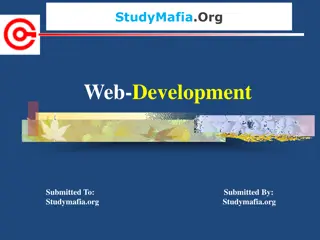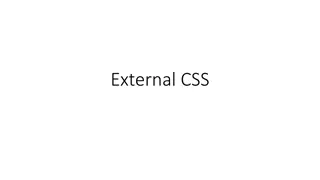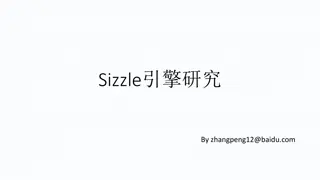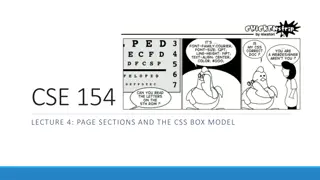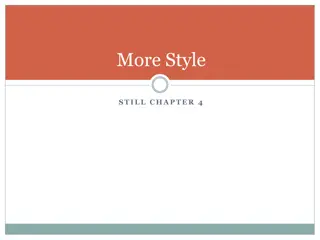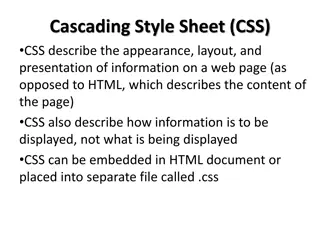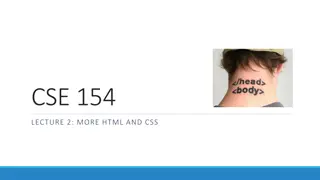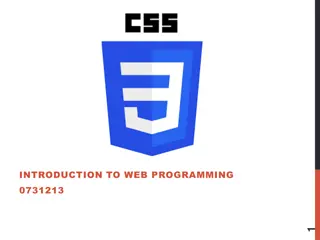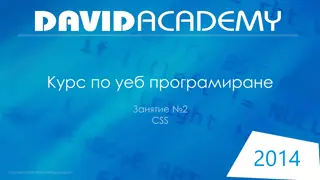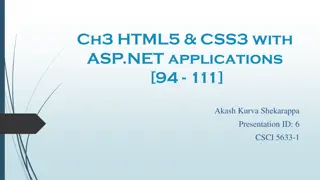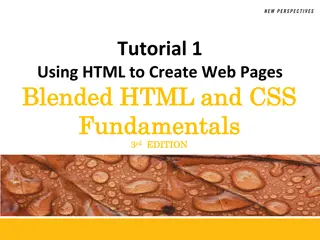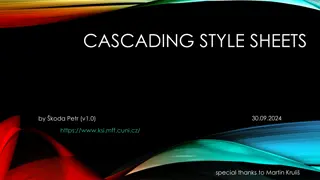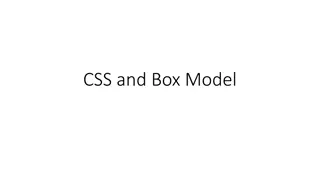Understanding CSS Basics and Best Practices
Cascading Style Sheets (CSS) play a crucial role in defining the appearance and layout of web pages. Learn about CSS syntax, inline styles, embedding style sheets, and essential CSS properties for fonts. Discover the importance of separating HTML content from CSS for efficient web design.
Download Presentation

Please find below an Image/Link to download the presentation.
The content on the website is provided AS IS for your information and personal use only. It may not be sold, licensed, or shared on other websites without obtaining consent from the author. Download presentation by click this link. If you encounter any issues during the download, it is possible that the publisher has removed the file from their server.
E N D
Presentation Transcript
CSE 154 LECTURE 3: MORE CSS
Cascading Style Sheets (CSS): Cascading Style Sheets (CSS): <link> <link> <head> ... <link href="filename" type="text/css" rel="stylesheet" /> ... </head> HTML CSS describes the appearance and layout of information on a web page (as opposed to HTML, which describes the content of the page) can be embedded in HTML or placed into separate .css file (preferred)
Basic CSS rule syntax Basic CSS rule syntax selector { property: value; property: value; ... property: value; } p { font-family: sans-serif; color: red; } a CSS file consists of one or more rules a rule's selector specifies HTML element(s) and applies style properties a selector of * selects all elements
Inline styles: the style attribute (BAD!) Inline styles: the style attribute (BAD!) <p style="font-family: sans-serif; color: red;"> This is a paragraph</p> This is a paragraph output HTML higher precedence than embedded or linked styles used for one-time overrides and styling a particular element this is bad style; DO NOT DO THIS (why?)
Embedding style sheets: <style> (BAD!) Embedding style sheets: <style> (BAD!) <head> </head> <style type="text/css"> p { font-family: sans-serif; color: red; } h2 { background-color: yellow; } </style> HTML CSS code can be embedded within the head of an HTML page this is bad style; DO NOT DO THIS (why?)
CSS properties for CSS properties for fonts fonts property description font-family which font will be used font-size how large the letters will be drawn font-style used to enable/disable italic style font-weight used to enable/disable bold style Complete list of font properties
font font- -size p { } size font-size: 14pt; This paragraph uses the style above. units: pixels (px) vs. point (pt) vs. m-size (em) 16px, 16pt, 1.16em vague font sizes: xx-small, x-small, small, medium, large, x-large, xx-large, smaller, larger percentage font sizes, e.g.: 90%, 120%
font font- -family family p { font-family: Georgia; } h2 { font-family: "Courier New"; } This paragraph uses the first style above. This h2 uses the second style above. enclose multi-word font names in quotes
More about font More about font- -family family p { font-family: Garamond, "Times New Roman", serif; } This paragraph uses the above style. can specify multiple fonts from highest to lowest priority generic font names: serif, sans-serif, cursive, fantasy, monospace
font font- -weight, font weight, font- -style style p { font-weight: bold; font-style: italic; } This paragraph uses the style above. either of the above can be set to normal to turn them off (e.g. headings)
Grouping styles Grouping styles p, h1, h2 { color: green; } h2 { background-color: yellow; } This paragraph uses the above style. This h2 uses the above styles. CSS output A style can select multiple elements separated by commas The individual elements can also have their own styles
CSS properties for text CSS properties for text property text-align text-decoration line-height, word-spacing, letter-spacing text-indent description alignment of text within its element decorations such as underlining gaps between the various portions of the text indents the first letter of each paragraph Complete list of text properties (http://www.w3schools.com/css/css_reference.asp#text)
text text- -align align blockquote { text-align: justify; } h2 { text-align: center; } CSS The Emperor's Quote [TO LUKE SKYWALKER] The alliance... will die. As will your friends. Good, I can feel your anger. I am unarmed. Take your weapon. Strike me down with all of your hatred and your journey towards the dark side will be complete. output can be left, right, center, or justify (which widens all full lines of the element so that they occupy its entire width)
Text Text- -decoration decoration p { } text-decoration: underline; CSS This paragraph uses the style above. output can also be overline, line-through, blink, or none effects can be combined: text-decoration: overline underline;
text text- -shadow shadow p { } CSS font-weight: bold; text-shadow: 2px 2px gray; This paragraph uses the style above. output shadow is specified as an X-offset, a Y-offset, and an optional color
The list The list- -style style- -type property type property ol { list-style-type: lower-roman; } Possible values: CSS i. none : No marker ii. disc (default), circle, square iii. Decimal: 1, 2, 3, etc. iv. decimal-leading-zero: 01, 02, 03, etc. v. lower-roman: i, ii, iii, iv, v, etc. vi. upper-roman: I, II, III, IV, V, etc. vii. lower-alpha: a, b, c, d, e, etc. viii. upper-alpha: A, B, C, D, E, etc. x. lower-greek: alpha, beta, gamma, etc. others: hebrew, armenian, georgian, cjk-ideographic, hiragana
CSS properties for backgrounds CSS properties for backgrounds property description background-color color to fill background background-image image to place in background background-position placement of bg image within element background-repeat whether/how bg image should be repeated background-attachment whether bg image scrolls with page background shorthand to set all background properties
background background- -image image body { } CSS background-image: url("images/draft.jpg"); background image/color fills the element's content area
background background- -repeat repeat body { background-image: url("images/draft.jpg"); background-repeat: repeat-x; } CSS can be repeat (default), repeat-x, repeat-y, or no-repeat
background background- -position position body { }CSS background-image: url("images/draft.jpg"); background-repeat: no-repeat; background-position: 370px 20px; value consists of two tokens, each of which can be top, left, right, bottom, center, a percentage, or a length value in px, pt, etc. value can be negative to shift left/up by a given amount
The opacity property body { background-image: url("images/marty-mcfly.jpg"); background-repeat: repeat; } p { background-color: yellow;} p.mcfly1 { opacity: 0.75; } p.mcfly2 { opacity: 0.50; } p.mcfly3 { opacity: 0.25; } CSS property opacity description how not-transparent the element is; value ranges from 1.0 (opaque) to 0.0 (transparent)
box-shadow box-shadow: h-shadow v-shadow blur; CSS box-shadow: 10px 10px 5px; CSS
Styles that conflict Styles that conflict p, h1, h2 { color: blue; font-style: italic; } h2 { color: red; background-color: yellow; } CSS This paragraph uses the first style above. This heading uses both styles above. output when two styles set conflicting values for the same property, the latter style takes precedence
Cascading Cascading style sheets style sheets It's called Cascading Style Sheets because the properties of an element cascade together in this order: browser's default styles (reference) external style sheet files (in a <link> tag) internal style sheets (in a <style> tag in the page header) inline style (the style attribute of an HTML element)
Inheriting styles ( Inheriting styles (explanation explanation) ) body { font-family: sans-serif; background-color: yellow; } p { color: red; background-color: aqua; } a { text-decoration: underline; } h2 { font-weight: bold; text-align: center; } This is a heading CSS A styled paragraph. Previous slides are available on the website. A bulleted list output when multiple styles apply to an element, they are inherited a more tightly matching rule can override a more general inherited rule not all properties are inherited (notice link's color above)





